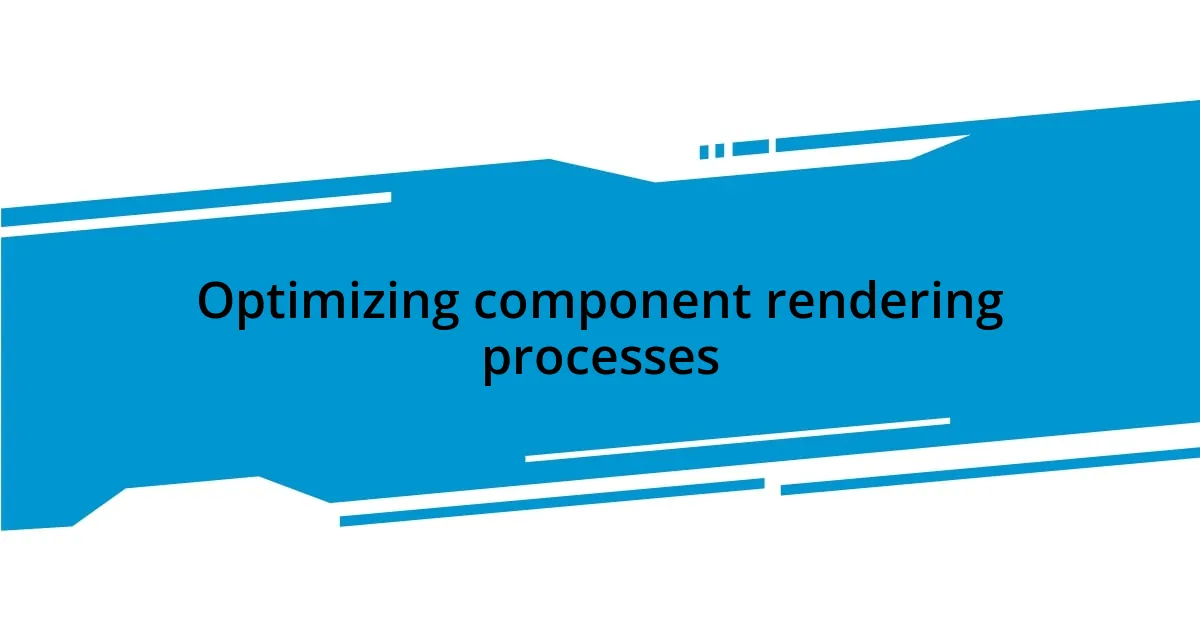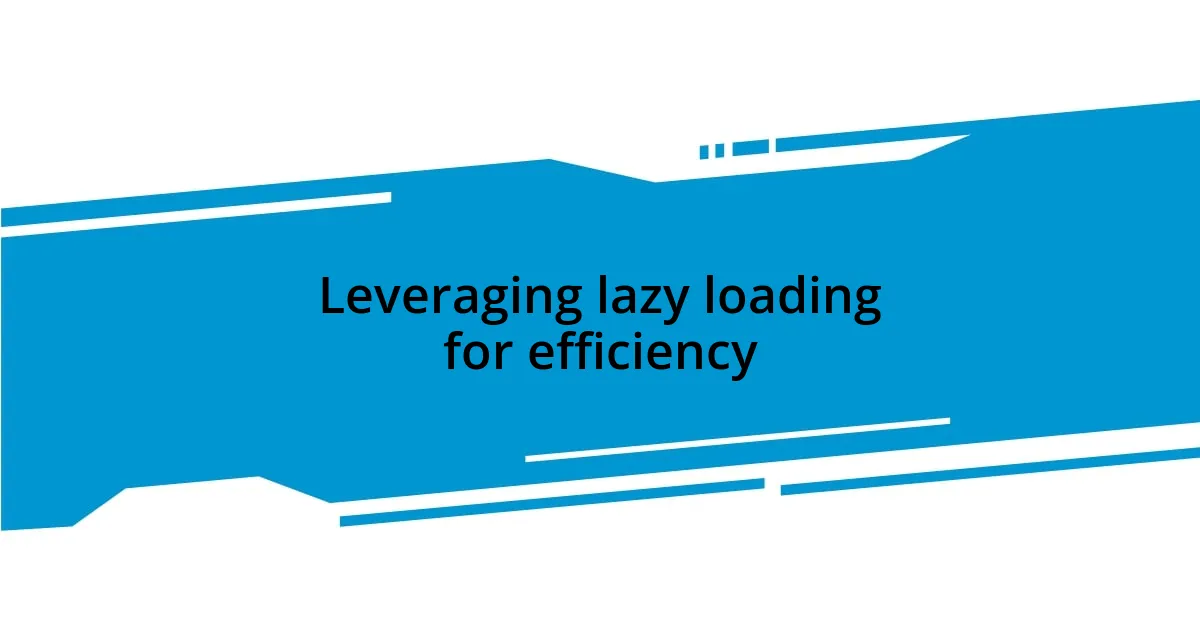Key takeaways:
- Unnecessary re-renders and mishandling of component lifecycles can significantly impact React app performance, necessitating careful state management and component updates.
- Utilizing tools like React Profiler and Chrome DevTools helps identify performance bottlenecks, making optimization more effective.
- Implementing memoization techniques, including React.memo, useMemo, and useCallback, can prevent unnecessary re-renders and boost performance.
- Lazy loading and code splitting strategies improve initial load times and overall user experience by loading components only as needed.

Understanding React performance issues
One of the most common performance issues I’ve encountered in React apps is unnecessary re-renders. I remember working on a project where a simple component was re-rendering way too often because it was connected to a large state object. Can you imagine the frustration when I realized that a small change in one part of my state was triggering updates throughout the entire component tree? It felt like watching a chain reaction unfold before my eyes.
Another issue that often sneaks up on developers is the mishandling of component lifecycles. There was a time when I neglected the shouldComponentUpdate lifecycle method, and the app’s performance took a serious hit. I learned the hard way that not controlling updates appropriately can turn a smoothly running application into a sluggish mess, and I couldn’t help but wonder—how many developers overlook this simple yet powerful tool?
As we dive deeper into React performance, one can’t ignore the impact of heavy dependencies. I’ve seen apps crash and burn because they relied too heavily on library features instead of maximizing React’s built-in optimizations. Have you ever felt that sinking feeling when a well-structured app feels cumbersome because of too many external packages? It’s moments like these that make me appreciate the beauty of a lightweight, optimized solution.

Identifying performance bottlenecks
Identifying performance bottlenecks in React applications is crucial for maintaining a responsive user experience. I’ve often found that the act of truly observing how my components behave can reveal surprising inefficiencies. For example, while debugging a particularly slow app, I used the React Profiler tool, and it was like shining a flashlight into a dark corner. I discovered that a single component was re-rendering unnecessarily, consuming valuable resources and slowing down the application.
To get started with identifying these bottlenecks, consider focusing on the following areas:
- Component Re-renders: Track what triggers re-renders by keeping an eye on props and state changes.
- React Profiler: Utilize the Profiler to measure the performance of your components during rendering.
- Network Requests: Monitor API calls and asynchronous operations to see if they’re causing delays.
- Long-running JavaScript: Identify functions that take too long to execute, especially during the render process.
- Memory Leaks: Check for unmounted components that are still holding on to state or listeners.
Recognizing these bottlenecks early saves time and enhances the app’s overall performance. It can be quite an enlightening experience, turning what initially feels like a tedious task into a treasure hunt for optimization opportunities.

Optimizing component rendering processes
When optimizing component rendering processes in React, one must be deliberate about how and when components update. I remember a time when I first introduced React.memo to one of my components. Initially, I was skeptical about its benefits. However, after I implemented it, I noticed a remarkable decrease in unnecessary renders, particularly in a complex component that dealt with heavy calculations. It felt satisfying to witness improvements in performance as if I’d finally uncovered a well-guarded secret to efficiency.
In addition to using React.memo, I found that breaking down larger components into smaller, isolated ones can drastically improve rendering performance. With one project, I had a massive component that handled multiple states. Once I refactored it into smaller pieces, each handling its own state, I felt an immediate sense of relief. The component tree became more manageable, and the app felt far more responsive. Have you ever thought about how a little restructuring could yield such significant gains? It’s often the subtle shifts in your component architecture that can lead to impressive results.
Lastly, I can’t overlook the importance of using the key prop in lists effectively. Early on, I tried to simplify things by using array indices as keys, thinking it wouldn’t make a difference. However, once I learned about the adverse effects of doing so, especially in terms of performance, I never looked back. Correctly assigning unique keys not only prevents unnecessary re-renders but also helps React identify which items have changed, are added, or are removed. It’s these small yet powerful optimizations that truly enhance the rendering process in React applications.
| Optimization Technique | Description |
|---|---|
| React.memo | A higher-order component that prevents a functional component from re-rendering if props haven’t changed. |
| Component Decomposition | Breaking down large components into smaller ones, managing their own states to improve updates. |
| Key Prop Usage | Using unique keys for items in lists to help React keep track of elements and reduce unnecessary updates. |

Implementing React’s memoization techniques
When diving into memoization techniques in React, I can’t stress enough how impactful React.memo has been in my projects. The first time I applied it, I felt like I’d turned on a hidden engine, giving my app a significant speed boost. It’s almost magical; by preventing functional components from re-rendering unless their props change, I’ve been able to eliminate certain performance issues that were like nagging little ghosts in my code. Have you ever experienced that moment of realization when a small change leads to something remarkable?
Another technique I found invaluable is utilizing useMemo and useCallback. They offer a way to memoize values and function definitions, respectively, which I learned the hard way. In one project, a specific computation took forever because it was recalculating on every render. Once I wrapped that value with useMemo, it felt as if I’d finally solved a puzzle that was holding my app back. This not only made my code cleaner but dramatically improved performance. It’s amazing to see how thoughtfully managing dependency arrays can lead to more fluid interactions in your application.
Lastly, never underestimate the importance of understanding your memoization strategy’s limits. I recall a scenario where overusing memoization led to increased complexity, making it harder to debug. Finding that sweet spot between performance and maintainability is vital. Have you ever faced a trade-off like that? Balancing the two can sometimes feel like walking a tightrope, but with experience, you learn to navigate it and find what truly serves your users best. Engaging with these techniques not only optimizes performance but also enhances the overall development experience.

Leveraging lazy loading for efficiency
When I first started implementing lazy loading in my React applications, the learning curve felt steep. I remember loading a hefty library all at once, and the initial render time was painfully sluggish. It was a game changer when I decided to only load components as needed. This method not only sped up the initial load, making the app feel much snappier, but it also reduced the resources pulled in from the server. Isn’t it fascinating how just changing when we load components can transform user experiences?
One of the standout moments for me was when I used React.lazy and Suspense together. I was developing a dashboard with several complex charts, which would have bogged down users with a long wait time. By wrapping the components with React.lazy, I could load them only when the user interacted with the section. Using Suspense, I could display a loading spinner instead of a blank screen, which felt so much more user-friendly. Have you ever considered how a little anticipation enhances the overall experience?
On a practical note, lazy loading has also helped address my worries about bandwidth usage, especially for mobile users. In instances where users had limited data plans, loading everything upfront could create frustration. By adopting lazy loading, I felt a sense of relief knowing that my apps were now friendlier to users in varying contexts. It’s satisfying to think about efficiency in terms of not just performance but also user satisfaction. Isn’t that what we’re all striving for?

Utilizing code splitting strategies
Utilizing code splitting strategies in React has always been one of those lightbulb moments for me. I remember the first time I implemented dynamic imports; it was like opening a window on a sunny day. Instead of bundling my app into a single, overwhelming file, I was able to break it down into smaller chunks that were loaded only as needed. This not only optimized performance, but it also felt liberating, knowing my users wouldn’t have to drain their devices waiting on unnecessary resources. Can you picture the impact of a smooth, quick-loading application on user experience?
A pivotal experience that stood out was when I integrated code splitting with React Router. I had a sprawling application with many routes, and initially, every user was downloading the entire codebase on entry. Once I adopted lazy-loaded routes, I could load specific components only when users navigated to those sections. I was amazed at how much it improved the app’s responsiveness. Have you ever felt that thrill of seeing your efforts result in a visibly snappier application? It shifted my focus to user experience, showing how important accessibility is.
Now, I often use React.lazy() alongside a dedicated chunking strategy. One particular memory springs to mind: I was working on an e-commerce site, and I noticed the homepage was taking ages to load. By chunking out the product pages and only fetching them when users wanted to see them, loading times shrank significantly. The joy from that accomplishment was almost palpable, knowing I was crafting a smoother experience for online shoppers. Isn’t it rewarding when your technical decisions lead to tangible benefits for users? Adopting code splitting not only streamlines performance, but also fosters a sense of pride in the work I do as a developer.

Monitoring performance with tools
Monitoring performance is a critical step in optimizing React applications, and I can’t stress enough how vital the right tools can be. My journey began with Chrome DevTools – a treasure trove for real-time performance tracking. The first time I explored the Performance tab, I was astonished by the insights it provided, like frame rates and JavaScript execution times. It’s one of those moments where you realize that data can illuminate potential bottlenecks in ways you never imagined. Have you ever dived into your app’s performance metrics only to discover hidden issues?
Another tool that has proven invaluable in my toolkit is Lighthouse. When I ran it for the first time on one of my projects, I was surprised by the detailed breakdown of performance metrics along with actionable suggestions for improvement. I recall tweaking various parts of my app and running the audit multiple times, each time feeling a sense of accomplishment as my scores crept higher. It’s like chasing a personal best—each improvement felt like a small victory. Can you relate to that thrill of reaching a goal you set for yourself?
And then there’s the React Profiler, which has become indispensable in my workflow. I remember an experience where I was puzzled by a sluggish component render. Using the Profiler, I traced the time spent on various components, ultimately uncovering a rerendering issue that I overlooked. It felt like solving a mystery, and that victory was sweet. Utilizing these tools not only empowered my development process but also reminded me how crucial it is to stay vigilant about performance. I often wonder: how much smoother would our apps be if every developer embraced performance monitoring as standard practice?
















